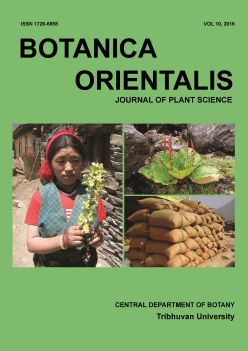Antioxidant and antibacterial activities of fruit extracts of Berberis species from Nepal
DOI:
https://doi.org/10.3126/botor.v10i0.21017Keywords:
Berberis species, antioxidant, antibacterial, phytochemical analysisAbstract
The Himalayan region is rich in flowering plants diversity, including medicinal and wild edible plants. These plants possess variety of therapeutically important compounds, like alkaloids, flavonoids, phenolics, saponins, steroids, tannins and terpenoids in different parts. Presence of significant amount of these compounds makes a species valuable to be used as super foods or medicines. Furthermore, plant extracts especially those of fruits are basically attributed with natural antioxidants, either in form of vitamins or color-inducing pigments, which have become the target to replace the synthetic antioxidants. In this regard, fruits of Berberis species, one of the popular wild edible fruits of Nepal, are noted for their antioxidant property since time immemorial. The present study was done with an attempt to quantify the antioxidant potential and antibacterial activities of the fruit extracts of four taxa of Berberis (B. angulosa var. angulosa, B. angulosa var. fasciculata, B. aristata and B. asiatica) from Nepal and to correlate the antioxidant potential with various phytochemicals present in the extracts. Methanolic fruit extracts were used to spectrophotometrically quantify total phenolic and flavonoid contents. DPPH free radical scavenging assay and antibacterial assay were carried out in in-vitro condition. Preliminary phytochemical analysis revealed high polyphenol content (52.60 ± 3.73 and 58.07 ± 1.44 mg GAE/g) and better antioxidant property (35.29 ± 3.01 and 29.15 ± 2.01 μg/ml) respectively in B. angulosa var. angulosa and B. angulosa var. fasciculata than in the fruit extracts of B. aristata and B. asiatica. In contrast, fruit extracts of B. asiatica showed the highest total flavonoid content (27.52 ± 0.56 mg QE/g) than did by the extracts of other taxa studied. The fruit extract of B. aristata and B. angulosa var. fasciculata at very high concentration (200 mg/ml) showed maximum zone of inhibition (ZOI) against tested bacterial strains, Staphylococcus aureus and Escherichia coli. In contrast, B. asiatica did not show any ZOI for both of the tested bacterial strains. As fruits are better sources of antioxidant with greater accumulation of flavonoids and phenolics, wild fruits should be equally spaced for their better efficiency as cultivated ones.
Botanica Orientalis – Journal of Plant Science (2016) 10: 6–11
Downloads
Downloads
Published
How to Cite
Issue
Section
License
This license enables reusers to copy and distribute the material in any medium or format in unadapted form only, for noncommercial purposes only, and only so long as attribution is given to the creator.




